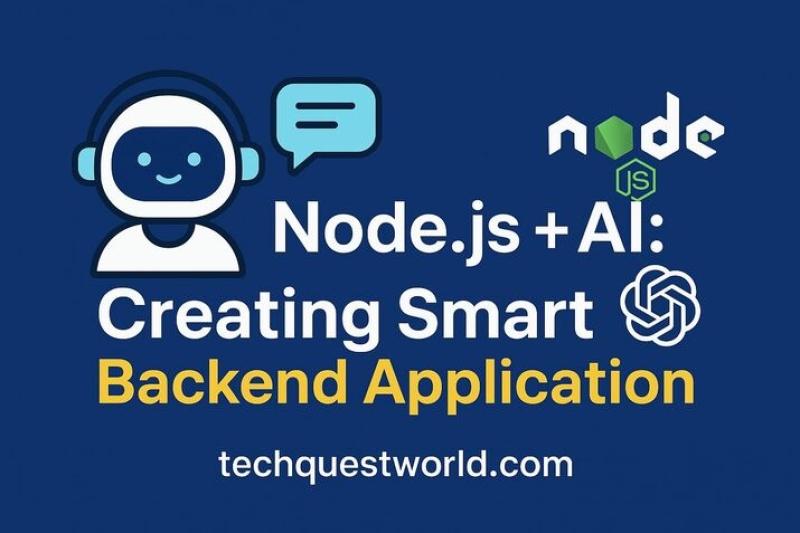Learn how to harness the power of AI in your Node.js backend applications. This guide walks you through integrating AI technologies to build intelligent, scalable and efficient backend systems.
🔹 Introduction
The fusion of Node.js and Artificial Intelligence (AI) is revolutionizing backend development. Node.js, known for its event-driven architecture and scalability, serves as an excellent platform for building real-time applications. When combined with AI, it enables the creation of intelligent systems capable of learning, adapting and making decisions.
In this guide, we'll explore how to integrate AI into Node.js backend applications, covering everything from setting up your environment to deploying AI-powered services.
🔹 Setting Up Your Environment
Before diving into AI integration, ensure your development environment is ready.
1. Grab Node.js (Comes with npm included)
Visit the official Node.js website and get your hands on the latest stable release — it's the safest and most reliable version to start building with confidence. Don't worry about npm — it’s already bundled with Node.js , so you get both in one shot.
2. Initialize a New Project
Start by creating a fresh folder for your project — think of it as your project's new home. Once inside, fire up the terminal and run npm init to get things rolling. This sets up your package.json file — the blueprint of your app.
3. Install Essential Packages
Install necessary packages for AI integration:
• Express: Web framework for Node.js.
• Body-parser: This middleware makes it easy to manage incoming data. It automatically parses the body of HTTP requests, allowing you to access user input without the usual hassle.
• axios: A modern, promise-based HTTP client that lets you send and receive data from external APIs with clean, readable code—ideal for interacting with AI services.
🔹 Integrating AI into Your Node.js Application
You can integrate AI into your Node.js backend in several powerful ways, transforming it into a smarter, more dynamic application. We'll explore two primary methods:
Method 1: Using Pre-trained AI Models via APIs
Services like OpenAI provide APIs to access powerful AI models.
a. Obtain API Access
Obtain Your Access Token from OpenAI
b. Create a .env File
Store your API key securely:
To manage your environment variables safely, go ahead and install the dotenvpackage.:
c. Implement the AI Integration
This setup initiates an endpoint /generate-text that accepts a prompt and returns AI-generated text.
Method 2: Utilizing AI Libraries in Node.js
For more control, you can use AI libraries directly within your Node.js application.
a. Install Essential AI Libraries
brain.js: A powerful JavaScript library designed for neural networks and machine learning tasks right in your Node.js app.
b. Implement a Simple Neural Network
Demonstrates a neural network that learns to sum two numbers.
🔹 Building a Smart Backend Application: A Step-by-Step Guide
Let's build a backend application that uses AI to analyze sentiment in text.
1. Set Up the Project
2. Obtain Sentiment Analysis API Access
You can use services like TextBlob via APIs or the Google Cloud Natural Language API.
For this example, we'll assume you have access to a sentiment analysis API.
3. Configure the Backend
Here, the backend is responsible for accepting user-submitted text and returning the sentiment analysis result.
Deploying Your AI-Powered Backend
Got your app ready? It's time to launch it into the world using deployment platforms like:
• Heroku: An ideal platform for quick deployments. Connect your Git repository and push your project live in minutes.
• Vercel: Optimized for frontend and serverless functions.
• AWS Elastic Beanstalk: Scalable deployment with AWS infrastructure.
Ensure you set environment variables securely on the deployment platform.
🔹Also Read
• Build a Chatbot That Thinks: OpenAI x Node.js Tutorial
• How to Train a Machine Learning Model in the Browser with TensorFlow.js
• Build a GPT-4 AI Chatbot with Node.js – Full Tutorial + Source Code (2025 Edition)
• How AI Is Transforming Web Development in 2025
🔹 Conclusion
Integrating AI into your Node.js backend applications opens up a world of possibilities, from enhancing user experiences to automating complex tasks. By leveraging APIs or incorporating AI libraries, you can build intelligent systems that learn and adapt.
Remember to:
• Choose the right AI integration method based on your application's needs.
• Keep your API keys and sensitive data safe with proper security practices.
• Continuously monitor and improve your AI models for optimal performance.
Level Up Your Development with Node.js and AI Integration.





